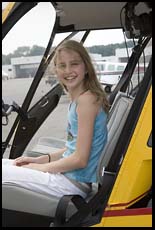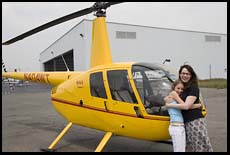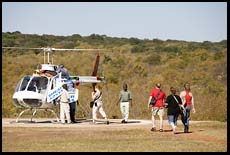
|
Helicopter Passenger Safety Card
for the Robinson R44 by Philip Greenspun, CFI-H; September 2006
Site Home : Flying : One Article
|
 You can break the helicopter and the helicopter can break you.
You can break the helicopter and the helicopter can break you.
Start by Stripping Down
Don't wear a hat or other loose clothing near the helicopter. The rotor
wash is likely to blow it away from you, which may cause you to run
after it, which may result in you running into the tail rotor
(see next section).
If we're flying with a door off, remove all items from your pockets and
place them under the seat. Without a door, items that are loose inside
the cabin will tend to blow out of the helicopter during flight and may
disable the machine by damaging the tail rotor.
Your Enemy, the Tail Rotor
Most people injured on the ground by helicopters have managed to walk
into the tail rotor. The best way to avoid this is to remain in the
helicopter until all blades have stopped spinning. If this is not
practical, approach or exit the helicopter while maintaining eye contact
with the pilot. If you can see the pilot, sitting in the front seat,
you cannot be back by the tail rotor.
Your Enemy, the Main Rotor
The blades on top of the helicopter may appear heavy and dangerous.
They are the wing of the aircraft and therefore heavy enough to support
the entire helicopter and its occupants. They are dangerous. If you are
standing right next to the helicopter, the blades are guaranteed to be
above your head. If you are near the edge of the rotor disk, the
clearance will depend on the terrain and where/how the pilot is holding
the cyclic pitch control (right hand). God many different kinds of
terrain on this Earth and the Coast Guard sends its smart pilots to
airplane school, leaving the meatheads to fly helicopters. Don't put
your trust in God or the pilot: remain in the helicopter until all
blades have stopped spinning. If this is not practical, approach or
exit the helicopter while ducking slightly.
The doors and seat belts
Push the belts together to join. Pull up on the latch to release. Open
the door by rotating the latch up and then pushing forward. In the
event of an emergency landing, follow the instructions of the pilot. In
an actual crash, if there are no instructions from the pilot, wait until
the blades have come to a stop and get out of the helicopter as quickly
as possible.
In the event that you survive a landing, if you get out and slam the
door, the owner/pilot will probably kill you. Robinson helicopter doors
cost several thousand dollars and weigh about 5 lbs. They are very
fragile. With any light aircraft, you gently push the door closed and
then latch it. Making the door secure depends on the latching
operation, not on how firmly you push the door closed to begin with.
The headsets
We use Telex noise-cancelling headsets. Each earcup has a volume
control that you can adjust for a comfortable level. The earcup
opposite where the microphone attaches has a button that you can push
for noise cancelling. Push it in and release; six seconds later the
noise cancelling should turn on. If you hear an immediate change in the
sound, that means you turned noise-cancelling off rather than on. So as
to avoid amplifying the interior noise of the helicopter, the intercom
and microphone are turned on only when you speak. You will have to keep
the microphone close to your lips to "break squelch" and be heard.
Nothing that you say will be transmitted over the radio to Air Traffic
Control or other aircraft. The pilot has a special switch to press when
he or she wants to talk on the radio. Only what is coming from the
pilot's microphone is sent out. If you and your friends are yakking,
the pilot has an "isolate" button that can be pushed so that you all can
go on talking, but the pilot hears only what comes from the radio.
The headsets cost $700 each. Please do not sit on them.
The windows
Light aircraft have plastic windows, which weigh less than glass. The
downside of plastic is that it scratches very easily. If you scratch
the bubble, it is easy to get a new one... for about $5000. Don't lean
on the bubble or on any of the other windows of the helicopter,
especially if you are wearing synthetic clothing. Acrylic windows can
be cleaned only with 100 percent cotton T-shirts or specially designed
wipes.
The little vent panels
Robinson puts little vent panels in each main door. You are not
supposed to open or close the panel by pushing the edge.
Counterintuitively, you are supposed to open and close the panel by
pushing and pulling on a white plastic knob over the hinge.
Working with ground handlers
 If you're reading this in preparation for a charity sightseeing ride, it
is likely that we're doing rides every 10 minutes and "hot loading" the
helicopter without shutting down the engine and rotor system. To keep
the operation safe, you will be escorted to the helicopter by a trained
ground handler. He will hold the door open for you, hand you your seat
belt, hand you the headset, and close and latch the door. You aren't
responsible for anything except latching your seat belt. At the end of
the flight, remain in your seat with the seat belt fastened and wait for
the ground handler to open the door. Once again, you aren't responsible
to do anything but unlatch your seat belt and follow the ground handler
to the edge of the landing zone.
If you're reading this in preparation for a charity sightseeing ride, it
is likely that we're doing rides every 10 minutes and "hot loading" the
helicopter without shutting down the engine and rotor system. To keep
the operation safe, you will be escorted to the helicopter by a trained
ground handler. He will hold the door open for you, hand you your seat
belt, hand you the headset, and close and latch the door. You aren't
responsible for anything except latching your seat belt. At the end of
the flight, remain in your seat with the seat belt fastened and wait for
the ground handler to open the door. Once again, you aren't responsible
to do anything but unlatch your seat belt and follow the ground handler
to the edge of the landing zone.
Take heart
By now you are probably afraid. Children as young as three years old
have ridden in the back of this helicopter, giddy with delight for 15
minutes and then fast asleep until landing; you, by contrast, are
quavering with fear. It is true that the helicopter demands respect and
is not forgiving. It is also true that sitting at home watching cable
TV is safer than flying in a helicopter. Many folks' fears about
helicopters are unfounded, however. For example, the helicopter will
fly in the event of engine failure. Without power, a helicopter glides
just like an airplane. The rush of wind from below keeps the blades
rotating while the helicopter flies at a normal airspeed of 70 knots.
Near the ground, the pilot terminates the autorotation with a flare back
to zero airspeed and the helicopter sinks remarkably gently to the
ground. Any licensed helicopter pilot has had to practice autorotations
dozens if not hundreds of times.
Text and photos Copyright 2006 Philip
Greenspun. The girls are my beloved cousins who took a ride with me
from Teterboro, NJ to the Statue of Liberty and all around Manhattan on a
gusty hazy day.
philg@mit.edu


 You can break the helicopter and the helicopter can break you.
You can break the helicopter and the helicopter can break you.
 If you're reading this in preparation for a charity sightseeing ride, it
is likely that we're doing rides every 10 minutes and "hot loading" the
helicopter without shutting down the engine and rotor system. To keep
the operation safe, you will be escorted to the helicopter by a trained
ground handler. He will hold the door open for you, hand you your seat
belt, hand you the headset, and close and latch the door. You aren't
responsible for anything except latching your seat belt. At the end of
the flight, remain in your seat with the seat belt fastened and wait for
the ground handler to open the door. Once again, you aren't responsible
to do anything but unlatch your seat belt and follow the ground handler
to the edge of the landing zone.
If you're reading this in preparation for a charity sightseeing ride, it
is likely that we're doing rides every 10 minutes and "hot loading" the
helicopter without shutting down the engine and rotor system. To keep
the operation safe, you will be escorted to the helicopter by a trained
ground handler. He will hold the door open for you, hand you your seat
belt, hand you the headset, and close and latch the door. You aren't
responsible for anything except latching your seat belt. At the end of
the flight, remain in your seat with the seat belt fastened and wait for
the ground handler to open the door. Once again, you aren't responsible
to do anything but unlatch your seat belt and follow the ground handler
to the edge of the landing zone.